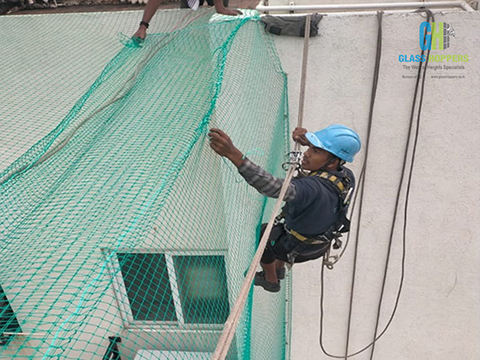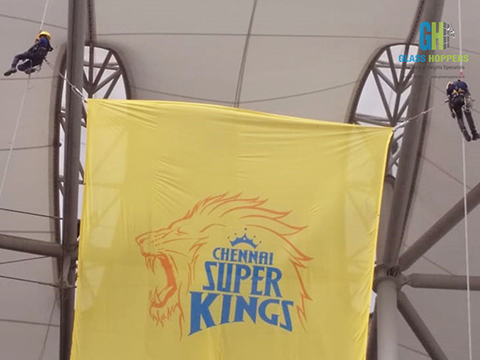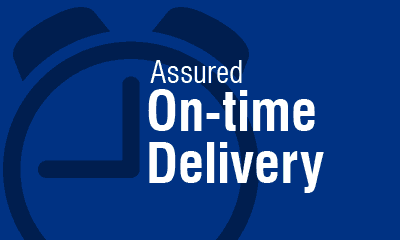Work at Heights Services
Any works that's above 10 Feet from the ground level can be considered as Work at Heights and all guidelines pertaining to Work at Heights shall be followed. Literally speaking, work at heights is a secondary work but a primary challenge and in most of the cases primary work need not necessarily be a challenge rather can be a simple and straight work for example replacing a bulb, anchoring a hoarding, fixing a signage but the common challenge is reaching the heights etc.
The most important challenge in work at heights is the safety of the work man and surroundings. However simple or complex the work is the workman and surroundings should not get affected due to accidents resulting out of improper planning or failure of the work at heights system.
This is paves way for understanding the various works at heights system and the same is elaborated below: The work at heights systems can be further classified on the basis of lifting man and materials, this article shall limit to man.
- Scaffolding-The most conventional and largely used system.
- Cradles
- Boom
- Scissors Lifts and
- Industrial Rope Access Systems
- Fall protection System a secondary system
- Fall arrestors system a secondary system
Irrespective of any height access system, the worker shall wear all PPE-personal protective equipments, given below as a minimum requirement and add any other gears, as required depending upon the risk and challenge to mitigate.
- Harness
- Lanyards
- Helmets
- Reflective jackets
- Goggles and
- Safety shoes
- Gloves
Now let's go back to work at heights system and detail it out for better understanding:
Scaffolding the good old work at heights system is good, mobile, and competitive in price when comes to new construction. However too laborious and restricts physical movement and hence not preferred on a live facility.
Cradles though this system has found some acceptance in the construction industry and in maintenance of high rise buildings, comes with problems like capital intensive, very difficult to get it serviced in case of repairs and to behave as sustained building maintenance unit (BMU). The problem is efficiency of the workers is diminished, as every time cradle has to be moved manually along with the terrace rigs. The workers in the cradle can work only within the length of the cradle or extend to their arms length on the both sides, for example if the cradle length is 10 feet the workmen can maximum work upto 15 feet by extending their arms a bit horizontally and vertically they have a free ride till the height of the building.
Presume you have to clean or paint or plaster or fix tiles all around the external walls of the building with a perimeter of 600 feet, you can do your work only upto 15 feet horizontally, at any given point of time with one cradle, this means though the work front is available for 600 feet, you can work only for 15 feet. This means you cannot increase manpower, without increasing the cradles and the same is capital intensive, therefore such systems kills the efficiency and delays the project and in such cases either scaffolding or industrial rope access is preferred. To sum up, if it is new construction like fixing tiles, claddings etc the most conducive system is scaffolding and if it is maintenance activity like cleanings and paintings, industrial rope access system shall be preferred any day.
Booms and Scissors lifts are the most conducive system to maneuver and take it when work locations are confined, not free of obstacles, works with quick turnaround time and works of non laborious nature are the tasks in hand. These systems are capital intensive and costs can be reduced if taken on hire.
Industrial Rope Access System is the most economical, safe, quick and conducive system for any kind of maintenance works at heights. The rope access system consists of the following equipments:
- Polymide Ropes-one for abseiling & other one for life line as a safety rope.
- Stop for descending
- Shunt for safety
- Harness-Full Body
- Karabiners as connectors
- Ascenders to climb
- Foot Lopes for Ascending
- Lanyards for work positioning
- Fall arrestors-Fall arrest systems protect you after you fall, they stop the fall before you hit the surface rather prevents a serious injury.
- All other PPE's
Why Industrial Rope Access is the safest system?
- The industrial rope access is considered to be the safest system as each equipment has got a load bearing capacity of 20KN and acts as fall prevention system.
- The rope access system has got 2 ropes as a standard arrangement, first rope used for abseiling and 2nd one comes into play, when the first one fails. The probability of both failing at the same time is highly remote.
- The other reasons why rope access is safe is due to the rescue system that is available, to rescue the coworker is simple, convenient and effective.
- Both fall protection systems and fall arrestor system can be created before venturing into work at heights.
Work at Heights Risk Assessments:
The rope access team before venturing into any work at heights has to completely assess the potential risks, challenges and have to work out plans to mitigate the same, as a routine process and this we call as Job safety Analysis and it is a mandatory client submittal along with engineering method statements. This explains how a particular work will be executed on a sequential basis, this helps the engineer in charge, to coordinate and make decisions, where multiple contractors are involved in the jobs, at the same location.
Medical fitness of Work at Heights Professionals:
Another important factor is the medical assessments of the work at heights professionals: The workers shall be physically and mentally fit and this needs to be supported with medical certificates submitted for each and every site
Please contact Glass Hoppers should you need any Work at Heights Services.





